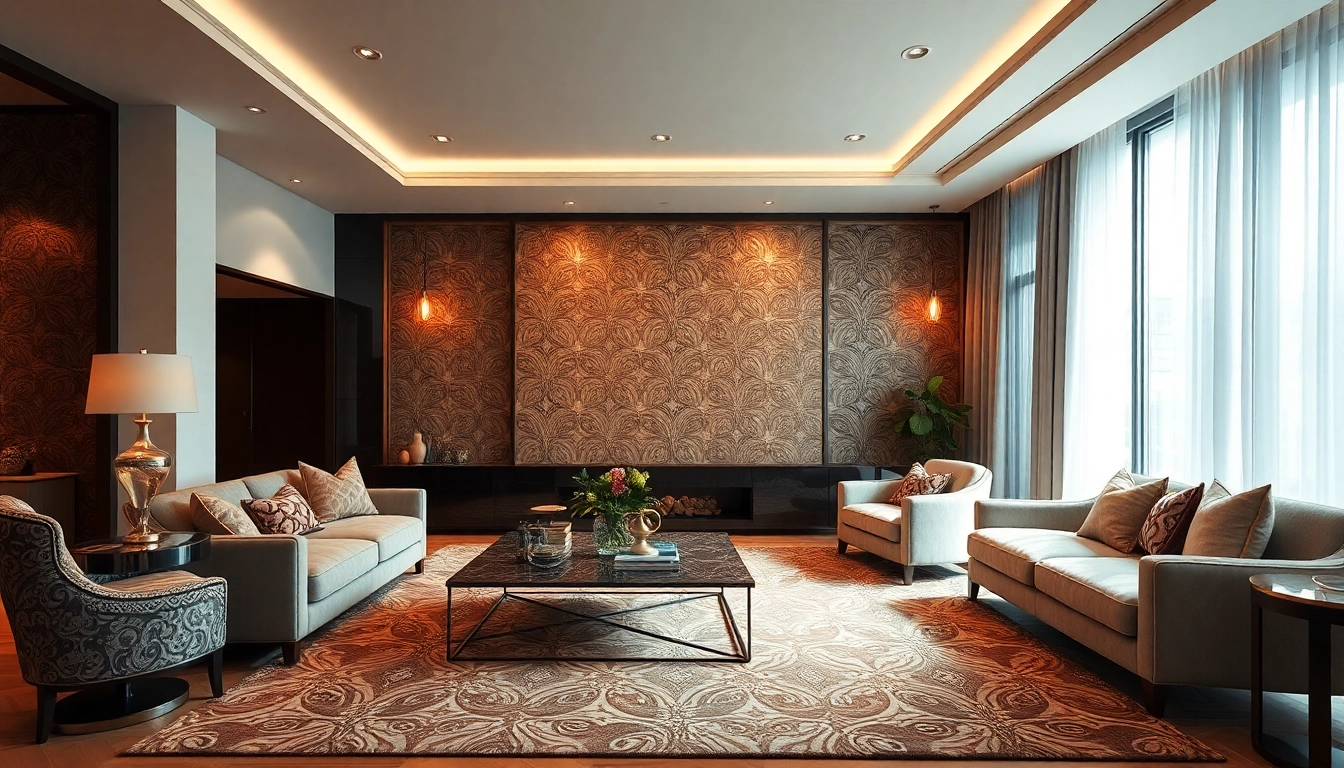Premium Tappeti a Milano: Elevate Your Interior with Expertly Crafted Rugs
Introduction to Tappeti a Milano: Heritage and Modern Trends
Milano has long been a hub of cultural sophistication, blending historical artistry with contemporary design. Among its rich heritage is the tradition of crafting and sourcing high-quality Tappeti a Milano, which translates to “Rugs in Milan.” These textiles are more than mere floor coverings; they embody centuries of craftsmanship, regional influences, and modern aesthetic sensibilities. Today, Milano’s rug scene seamlessly integrates traditional techniques with innovative design trends, creating a dynamic market that appeals to both connoisseurs and modern homeowners.
From ancient Persians and Caucasian tribes to contemporary geometric patterns, the diversity of Milanese rug offerings reflects a vibrant cultural tapestry. This article explores this evolution, guiding you through the rich heritage, the current market landscape, and expert insights into choosing, maintaining, and appreciating the finest Tappeti in Milano.
Understanding the tradition of Milanese rugmaking
The tradition of rug making in Milan is deeply rooted in the city’s history as a center of trade and craftsmanship. Historically, Milanese artisans imported richly woven Persian, Turkish, Caucasian, and Chinese carpets, which were prized among nobility and aristocrats. These imported rugs served not only as decorative pieces but also as symbols of status and cultural exchange. Over the centuries, local artisans began to develop their own techniques, blending imported motifs with indigenous designs, giving rise to a unique Milanese style.
Today, this heritage persists through specialized ateliers and showrooms that uphold centuries-old craftsmanship. Milanese rugmaking often involves intricate hand knotting, punch needle techniques, and the use of premium materials such as wool, silk, and cotton. Notable historical centers, like the prestigious Brera district, still host artisanal workshops that produce bespoke pieces tailored to modern tastes, ensuring that traditional values are preserved amidst contemporary evolutions.
Current design trends and customer preferences
Modern customers in Milano are increasingly looking for rugs that complement stylish, minimalist, and even eclectic interiors. The trend towards simplicity is often balanced by bold patterns, colors, and textures in contemporary Tappeti a Milano. Geometric designs, abstract motifs, and subdued color palettes—such as neutral grays, soft beiges, and monochrome tones—are highly sought after, offering versatility and timeless appeal.
At the same time, there is a revived enthusiasm for traditional Persian and Oriental rugs, appreciated for their artisanal craftsmanship and intricate designs. Clients often seek rugs that serve as statement pieces or focal accents within a room. Sustainable and eco-friendly materials are also gaining popularity, aligning with a broader environmental consciousness that influences purchasing decisions.
Customize options, including size, material, and pattern, are increasingly in demand, allowing buyers to create personalized, one-of-a-kind pieces that reflect their individual style. The fusion of old-world charm with new-age aesthetics characterizes the current Milanese market, making Tappeti a Milano a reflection of both history and innovation.
Overview of the local market and availability
Milano’s market for high-quality rugs is diverse and vibrant. It encompasses luxury showrooms, outlet stores, online boutiques, and specialized artisans. Notable showrooms like Artorient Milano offer extensive collections, ranging from classic persian designs to modern geometric styles. These establishments often feature authentic, handcrafted pieces alongside contemporary designs, catering to a wide spectrum of preferences.
Numerous outlets and vendors have established a strong presence both physically and online to meet the increasing demand. Websites such as outlettappeti.com and zaltappeti.com provide comprehensive catalogs, virtual consultations, and delivery services, making access to premium rugs easier than ever.
Additionally, Milan is home to dedicated centers specializing in rug restoration, cleaning, and customization, ensuring that antique and modern rugs can be preserved and tailored to fit individual needs. This widespread availability positions Milano as a leading global destination for both connoisseurs and casual buyers seeking authentic and high-quality Tappeti.
Choosing the Right Tappeti a Milano for Your Space
Factors to consider: size, material, and style
Selecting the ideal rug begins with assessing your space and needs. Size is crucial; a rug should complement the room’s dimensions, anchoring furniture without overwhelming the space. Typically, larger rugs are suitable for open-plan living rooms or dining areas, while smaller, accent rugs fit bedrooms or entryways.
Material choice impacts durability, comfort, and maintenance. Wool offers softness and resilience, making it perfect for high-traffic areas. Silk provides a luxurious sheen but requires delicate handling, whereas polypropylene or synthetic fibers can be more budget-friendly and easier to clean.
Style considerations should mirror or enhance your interior design theme. Modern minimalist spaces benefit from simple, monochrome patterns, while traditional settings might favor ornate Persian or kilim designs. Milanese buyers increasingly opt for personalized solutions, blending materials, patterns, and colors to create harmonious environments.
Matching rugs with interior design themes
A well-chosen rug can unify your interior decor. For contemporary interiors, geometric and abstract designs in neutral colors are ideal. Classic or vintage decor benefits from richly detailed Persian or Tabriz rugs, adding warmth and elegance. Eclectic styles allow for bold colors and contrasting patterns, creating visual interest.
Practical tips include considering the room’s color palette and furniture style when selecting a rug. For example, a neutral sofa pairs well with a vibrant kilim, while a patterned rug can serve as a subtle background for modern art pieces.
Budget planning and value assessment
Determining your budget is essential. High-quality, handmade Milanese rugs can be an investment, often costing thousands of dollars depending on size and rarity. However, the durability and timeless appeal of these pieces mean they retain value over time.
To maximize value, consider the rug’s craftsmanship, material, and source authenticity. Purchasing from reputable vendors, such as recognized showrooms or certified online stores, ensures quality and authenticity. Additionally, exploring outlets and sales events can help find exceptional pieces within your budget.
Quality and Craftsmanship of Milano Tappeti
Handmade techniques and artisan skills
The hallmark of authentic Milano rugs lies in their handmade craftsmanship. Artisans employ traditional knotting, weaving, and dyeing techniques passed down through generations. Hand knotting, in particular, is a meticulous process that can take months or even years for intricate designs, ensuring each rug’s uniqueness.
Skilled artisans often work with natural dyes derived from plants, minerals, and insects, resulting in vibrant, durable colors that age gracefully. This artisanal approach differentiates genuine Milanese rugs from mass-produced imitations.
Material durability and comfort
Premium materials such as Himalayan wool and silk not only deliver visual richness but also ensure longevity. Wool is resilient, stain-resistant, and comfortable underfoot, making it suitable for daily use. Silk, though delicate, adds an unmatched luster and finesse, often reserved for decorative or low-traffic areas.
Certification and authenticity indicators
Authentic Milanese or imported high-quality rugs often carry certification labels, including origin certificates and artisanal trademarks. Look for signs such as label tags, detailed provenance documentation, and consistent craftsmanship patterns to verify authenticity. Reputable vendors provide detailed origin stories and care instructions, adding confidence in your purchase.
Where to Buy Tappeti a Milano: Best Shops and Outlets
Top local stores and showrooms in Milan
Milano hosts numerous prestigious showrooms offering curated collections of authentic rugs. Artorient Milano is renowned for its extensive selection, featuring modern, Persian, Caucasian, and vintage pieces. Other notable shops include Cohen Tappeti, established since 1960, which specializes in handcrafted rugs with a mix of classical and modern designs.
Online options for convenient shopping
For ease and wider variety, online shops like outlettappeti.com and zaltappeti.com offer comprehensive catalogs with detailed images, descriptions, and virtual consultation options. These platforms often provide flexible shipping and return policies, making high-quality Tappeti accessible from the comfort of your home.
Tips for selecting reputable vendors and avoiding imitations
Always verify vendor credentials, request provenance documentation, and examine detailed photographs of the rugs. Confront sellers with questions about craftsmanship, materials, and certifications. Reading customer reviews and seeking recommendations from interior designers can also help identify trustworthy sources.
Maintenance and Care of Your Milano Rugs
Routine cleaning and stain removal tips
Regular vacuuming without a beater bar helps preserve pile and prevent dust accumulation. Rotating the rug periodically ensures even wear. Address stains promptly with gentle blotting techniques and mild cleaning solutions suitable for the material—avoid harsh chemicals that can damage natural fibers.
Professional cleaning and restoration services
For deep cleaning and restorations, consult specialized Milanese services like Art Tappeti. Professionals use water-based cleaning and apposite repair techniques to restore antique or heavily used rugs, prolonging their lifespan.
Preservation strategies to extend rug lifespan
Protect rugs from direct sunlight to prevent fading, use underlay pads to minimize slippage and wear, and keep the environment dry and well-ventilated. Periodic inspections can catch early signs of moths, pests, or fiber deterioration, allowing for timely intervention.

